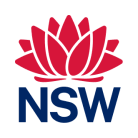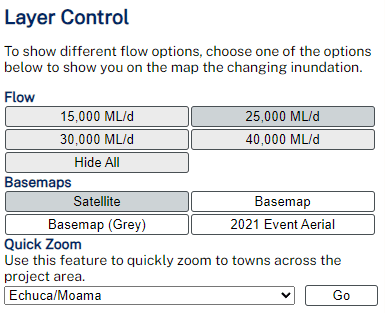 Reconnecting River Country Program inundation extent web viewer
Reconnecting River Country Program inundation extent web viewerMurray River: Yarrawonga Weir to Wakool Junction
Welcome to the Reconnecting River Country Program inundation interactive map. The map provides access to the program's modelled outputs showing potential inundation for the flow rates being investigated.
This app focuses on the Murray River between the Yarrawonga Weir and its confluence with the Wakool River. The default flow option displayed in the app is 15,000 ML/d at Yarrawonga Weir, which is the current temporary operational limit.
What's new
The interactive map has been updated to simplify and improve the inundation information presented. The updates include:
- New satellite only basemap added
- Satellite imagery colours enhanced
- New Quick Zoom functionality
- Symbology updates
- New basemaps sourcing data from NSW Spatial Services which includes property boundaries
- For Torrumbarry to Barham (and including Koondrook Perricoota and Gunbower forests), the base case (15,000 ML/d) inundation extent has been revised. The extent mapped previously was incorrect, being for a higher flow
- 35,000 ML/d and 45,000 ML/d flow limit options added, as modelling has become available
- For Torrumbarry to Barham (and including Koondrook Perricoota and Gunbower forests) the base case (15,000 ML/d) inundation extent has been revised. The extent mapped previously was incorrect, being for a higher flow
- Model zones merged to provide seamless mapping for each project area
- Modelled levees and embankments have been added to the mapping
- Modelled flows at gauges are now provided in table form to allow easier viewing
- Gauge board diagrams were added for some gauges. The remaining gauges will be added in the future once the analysis is complete
- Additional text was added to the banner to describe the potential frequency, timing, and duration of flows
- Additional text was added to describe assumptions regarding Goulburn River inflows
Future model revisions
The NSW Department of Climate Change, Energy, the Environment and Water (DCCEEW) is continuing to seek feedback from landholders on the accuracy of the mapping and also continuing to check the models against flow events in recent years. This work will lead to refinements in the modelling and mapping over time. Past revisions to the modelling are listed above and any future revisions will also be identified here.
DCCEEW is also working to complete the modelling of the 35,000 ML/d and 45,000 ML/d flow limit options for the Yarrawonga to Wakool Junction project area. This mapping will be published when available, likely in early to mid-2024.
Using the app
To show different flow options, choose one of the layers and it will show you on the map the changing inundation.

You can also zoom and pan around the map using your mouse and the included tools:

Zoom In

Zoom out

Search

Default view
Base Maps
Base map options can be toggled in the Layer Control and can be displayed below inundation extents:
Satellite
Composite satellite imagery represents a collection of recent
satellite photographs captured and delivered in high resolution.
Basemap
A cartographic layer from OpenStreetMap representing physical
features on the ground such as roads, rail, localities, national parks and other features
across the landscape.
2021 Event aerial photography
Aerial photography of a recent natural flow
event between August and December 2021. This imagery was only captured for some areas of the
program by the NSW DCCEEW.
Bridges
The mapping shows the extent of inundation, including the presence of water under road, highway and rail bridges. For bridges, the mapping does not accurately indicate inundation. The mapping product is overlain over aerial imagery which may appear to show bridges as being overtopped by water, but may represent water under the bridges.
More information
For more information on the program, please refer to the Reconnecting River Country Program Information hub on the DCCEEW website.